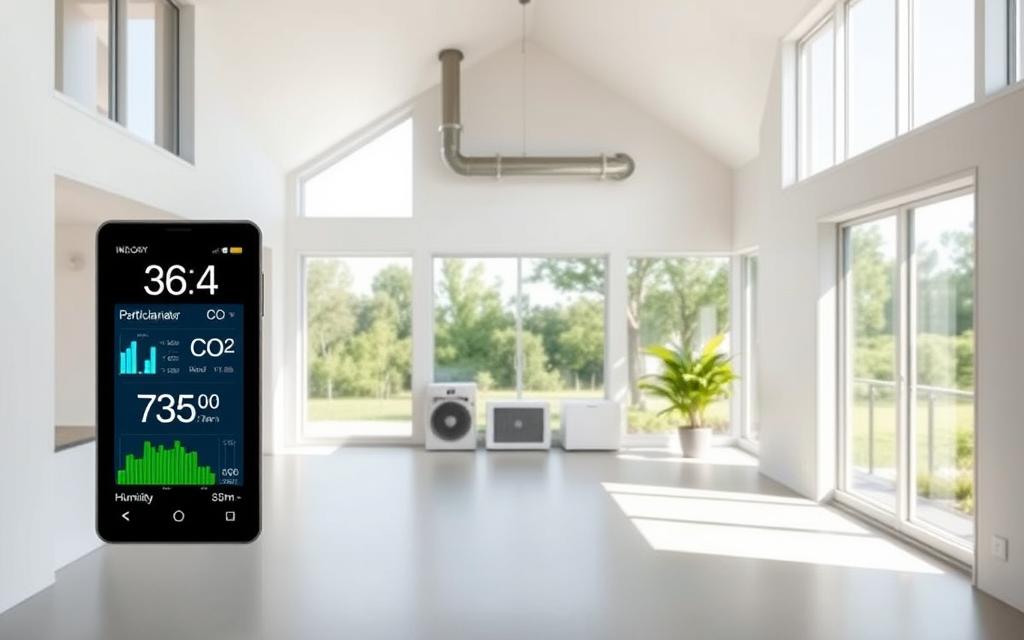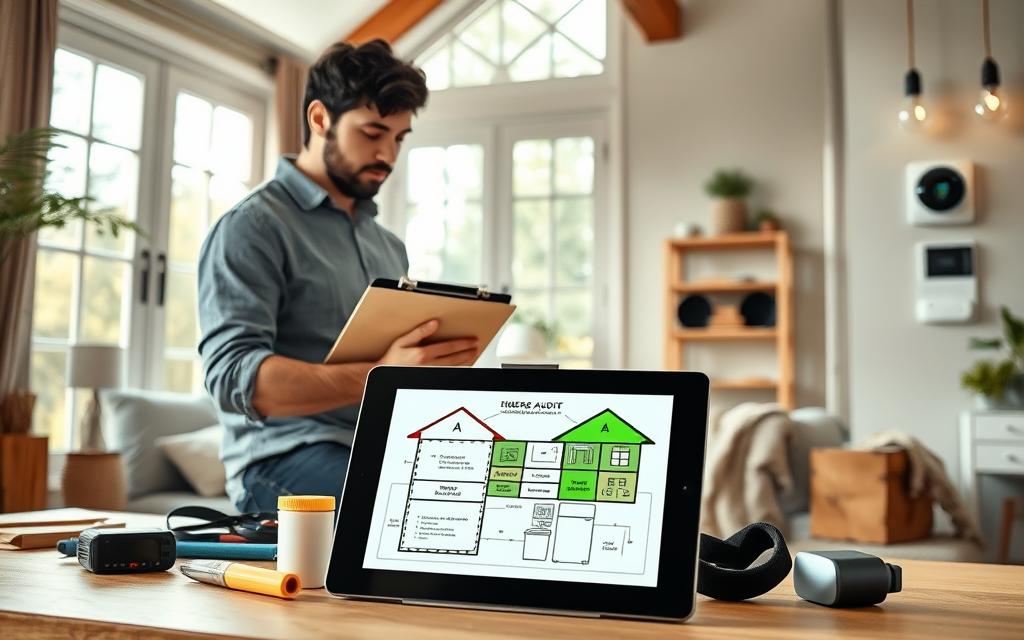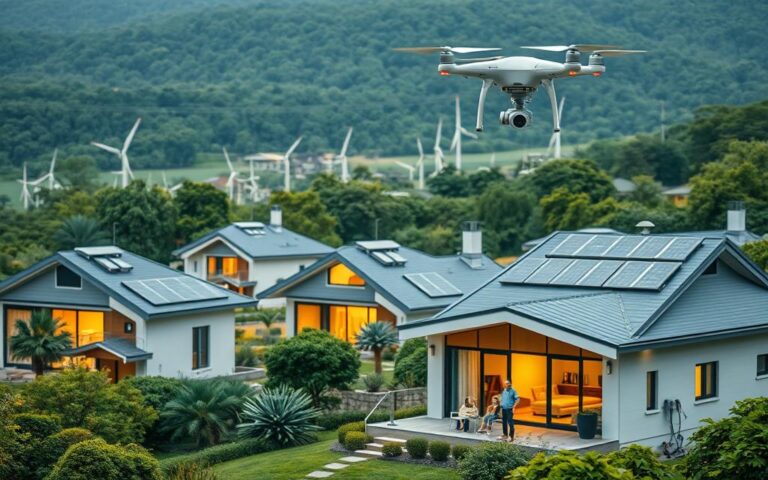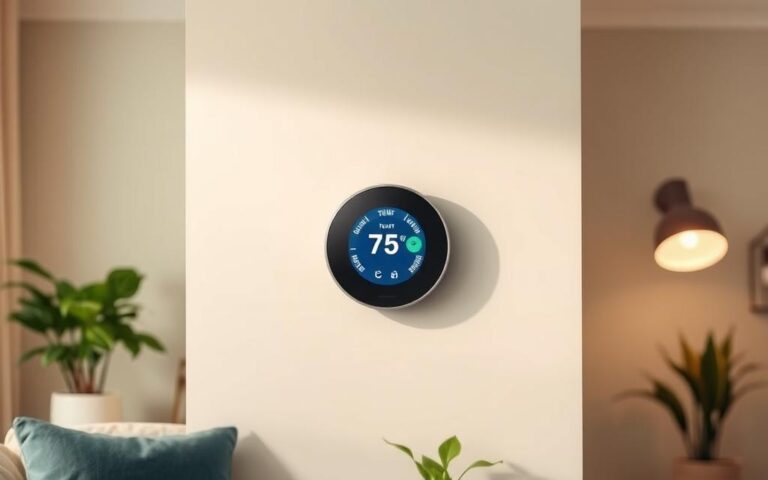Did you know the average American household spends about $2,200 a year on energy bills? This shows how crucial energy efficiency is in our homes. A DIY home energy audit is key for homeowners wanting to cut down on energy waste. It helps you find ways to make your home more comfortable and reduce your carbon footprint.
In this guide, we’ll show you how to do a detailed home energy audit. This will help you make choices that are good for the planet and save you money.
What is a Home Energy Audit?
A home energy audit is a detailed check of how much energy your home uses. It helps find ways to use less energy and save money. It also makes your home more comfortable, safe, and eco-friendly.
Definition and Purpose
A home energy audit looks at how much energy your home uses. It finds areas where you can use less energy. This makes your home more energy-efficient and helps the environment.
Benefits of Performing an Audit
Getting a home energy audit has many benefits:
- Lowered energy bills through optimized energy use.
- Increased awareness of one’s carbon footprint.
- Identification of critical upgrades or repairs needed for improved efficiency.
- Enhanced comfort levels within the home.
When to Consider an Audit
There are several times when you might want to get a home energy audit:
- When constructing new homes with a focus on energy-efficient houses.
- When retrofitting an existing residence.
- When purchasing a new home and assessing long-term energy costs.
- During instances of rising energy expenses that require investigation.
Preparing for Your Energy Audit
Getting ready for a home energy audit is important. You need to know what tools are needed, what questions to ask, and what goals to set. This helps you understand your energy use and move towards more energy-efficient homes.
Tools and Equipment Needed
Having the right tools is key for a good audit. You should get:
- Infrared thermometer for spotting heat leaks
- Energy monitors to track consumption
- Weather stripping to secure windows and doors
- LED bulbs to replace traditional lighting
- Notepad for taking detailed observations
Questions to Ask Yourself
Thinking about important questions can help set your goals. Ask yourself:
- What is my average monthly energy use?
- Which appliances are the most energy-consuming?
- What is my budget for energy improvements?
- How can I make my home more eco-friendly?
Setting Goals for Energy Efficiency
Setting clear goals is crucial for success. Aim for things like:
- Reducing overall energy consumption by a specific percentage
- Lowering monthly utility bills
- Improving insulation for greater comfort
- Transitioning to renewable energy sources for eco-friendly homes
Inspecting Your Home’s Exterior
Checking your home’s outside is key to finding energy-saving problems. Look at insulation, air leaks, windows, doors, and the roof. A detailed check boosts your home’s look and supports green living.
Evaluating Insulation and Air Leakage
Insulation stops heat from escaping. Check your attic, walls, and basement for enough insulation. Air leaks can be found around fixtures.
Use a blower door test or infrared camera to find hidden leaks. Fixing these can cut down on energy costs and help the planet.
Checking Windows and Doors
Windows and doors need a close look for wear or bad seals. Look for gaps, drafts, or broken seals. These can let heat out or cold in.
Switching to double or triple-pane windows helps save energy. Weather stripping and caulking can also block air leaks, helping the environment.
Roof and Siding Considerations
The roof and siding affect your home’s energy use. Make sure your roof reflects sunlight to keep temperatures steady. Choose siding made from eco-friendly materials for better efficiency.
Fixing these areas makes your home look better and supports green living.
Assessing Heating and Cooling Systems
Understanding and optimizing heating and cooling systems is key to saving energy at home. There are many HVAC systems, each for different climates and energy needs. Checking these systems helps them work well with your home’s energy goals, like net zero energy homes and carbon-neutral housing.
Types of Systems to Review
Common heating and cooling systems include:
- Central Air Conditioning Systems
- Heat Pumps
- Furnaces
- Boilers
- Ductless Mini-Split Systems
Maintenance Tips for Efficiency
Regular maintenance keeps heating and cooling systems efficient. Here are some tips:
- Clean or replace filters monthly, especially during peak usage seasons.
- Use programmable thermostats to optimize temperature settings and reduce energy usage.
- Schedule annual professional inspections for furnaces and air conditioning units.
Indicators of Inefficiency
Knowing signs of inefficiency helps improve your systems:
- Inconsistent temperatures throughout the home.
- Excessive energy bills compared to previous years.
- Noisy operations indicating potential mechanical issues.
- Unpleasant odors coming from HVAC units.
By managing heating and cooling systems well, homeowners can greatly improve energy use. Good systems help reach goals of carbon-neutral housing and net zero energy homes.
Evaluating Electrical Systems
Checking your home’s electrical systems is key to saving energy. Look at your lighting and appliances to find ways to cut costs. Knowing which devices use a lot of energy helps manage it better.
Smart home tech is a big plus for keeping an eye on energy use. It makes managing your home’s energy easier.
Assessing Lighting and Appliances
Begin by looking at all your lights and appliances. LED lights use much less energy than old bulbs. Also, look for Energy Star labels on appliances to choose eco-friendly options.
Identifying Energy-Hungry Devices
Some gadgets use a lot more energy than others. Find out which ones, like old fridges or heaters, need to be replaced. Using energy monitors helps see how much you use each day.
The Role of Smart Home Technology
Smart home tech is crucial for saving energy. It lets you watch your energy use live. Features like auto-off lights and remote thermostat control save a lot of energy.
Adding solar panels makes your home even more energy-efficient. It’s a green way to live.
Analyzing Water Usage
Understanding and optimizing water usage is key for better home energy efficiency. It helps make homes more eco-friendly and supports sustainable living. By focusing on fixtures, hot water systems, and simple changes, we can save a lot of water and energy.
Fixtures and Fittings to Inspect
Start by checking faucets, toilets, and showerheads for leaks and efficiency. A small leak can waste a lot of water over time. Switching to low-flow fixtures can save money on water bills and is an easy step towards being more sustainable.
Hot Water Systems and Their Efficiency
Hot water systems use a lot of energy in homes. Check the water heater for wear and think about getting a more efficient one. These models have better insulation and use less energy when not in use. This change helps your home use less energy and is better for the environment.
Tips to Reduce Water Heating Costs
Lowering the water heater thermostat to 120°F can cut energy costs. Insulating hot water pipes also helps by reducing heat loss. Using low-flow fixtures means less water needs to be heated, saving even more energy. These small changes help us use water more wisely and live more sustainably.
| Practice | Benefit |
|---|---|
| Inspect fixtures | Identifies leaks and inefficiencies |
| Upgrade to low-flow fixtures | Reduces water consumption |
| Adjust thermostat | Decreases energy costs |
| Insulate hot water pipes | Minimizes heat loss |
The Importance of Ventilation
Good ventilation is key to keeping air clean inside while saving energy. Knowing about ventilation types helps make homes both efficient and eco-friendly. There are two main ways to ventilate: naturally and mechanically.
Natural vs. Mechanical Ventilation
Natural ventilation uses outside air to refresh indoor spaces. Open windows and vents help without needing machines. On the other hand, mechanical ventilation uses fans and ducts for steady airflow, even when windows are closed. Choosing the best method depends on many factors, like weather, home design, and energy-saving goals.
Signs of Poor Ventilation
Signs that ventilation might be off include:
- Too much humidity, causing discomfort and damage.
- Mold, which is bad for health and lowers property value.
- Stale smells, showing trapped air and pollutants.
Spotting these signs early helps fix ventilation problems quickly.
Solutions for Improved Airflow
Improving airflow helps the environment. Ways to do this include:
- Putting in exhaust fans in wet areas like kitchens and bathrooms.
- Using energy recovery ventilators to swap stale air for fresh air.
- Trying passive cooling methods, like shading and landscaping, to cut down on machine use.
These steps not only clean the air but also make homes more energy-smart.
Conducting an Indoor Air Quality Check
Indoor air quality is key to a healthy home. It affects how comfortable we feel and how much energy we use. Knowing about common pollutants helps us make our air better. This can save energy and help our planet, especially in green homes.
Common Indoor Pollutants
Common indoor pollutants include:
- Volatile Organic Compounds (VOCs) – found in paints, cleaning supplies, and indoor plants
- Dust and allergens – from furniture, carpets, and the outdoor environment
- Carbon monoxide – often created by gas appliances or vehicles
- Mold and mildew – thrive in damp areas
Impact of Air Quality on Energy Efficiency
Poor air quality means we use more energy. When air is full of pollutants, we crank up the heat or AC. Good air quality helps our systems work better, which is great for green homes.
Improving Air Quality for Energy Savings
Here are ways to improve air quality:
- Regular maintenance of HVAC systems to ensure proper filtration and ventilation
- Implementing air purifiers or high-efficiency particulate air (HEPA) filters to capture pollutants
- Controlling humidity levels to prevent mold growth
- Using natural cleaning products to minimize VOCs

Measuring Energy Consumption
Understanding how much energy you use is key to making your home more energy-efficient. By tracking your energy use, you can see where you can save. This helps you make your home more sustainable.
How to Read Your Utility Bill
Your utility bill is a treasure trove of information about your energy use. Here’s what to look for:
- Usage History: Check your monthly use over the last year to spot trends.
- Peak Usage Times: Find out when you use the most energy.
- Rate Structure: Know if your rate is fixed or variable.
Tools for Measuring Energy Use
There are many tools to help you track your energy use:
- Smart Meters: These give you real-time data on your energy use.
- Energy Monitors: They track how much energy each appliance uses.
- Home Energy Management Systems: These systems manage all your smart devices for better energy use.
Calculating Energy Savings Potential
To figure out how much you can save, compare your current energy use to what you could save with upgrades. Think about these points:
- Current Consumption: Record your total energy use from bills or tools.
- Projected Savings: Guess how much you’ll save with upgrades like better insulation or efficient appliances.
- Return on Investment: Figure out how fast you’ll get your money back through savings.
Making an Action Plan
After your energy audit, making a detailed plan is key to better home energy use. This plan will guide you to make the biggest improvements. It also fits your budget and schedule. By doing this, you help make your home more eco-friendly.
Prioritizing Energy Efficiency Improvements
Start by sorting improvements by how much energy they save and their long-term benefits. Think about:
- Cost-effectiveness of upgrades
- Impact on overall energy consumption
- Feasibility of installation or modifications
Choosing the best improvements will help turn your home into a green haven.
Budgeting for Your Upgrades
After picking your top improvements, create a budget that suits your finances. Remember to include costs for materials, labor, and any professional help. Look at energy-efficient options that cost more upfront but save money later. This step moves you closer to your green building dreams.
Setting a Timeline for Implementation
Having a clear timeline makes managing your project easier. Choose realistic times for each upgrade and stay flexible. Regular checks on your progress will keep you on track. This helps you keep improving your home for a greener future.
Implementing Energy Efficiency Upgrades
Upgrading your home’s energy efficiency is a rewarding journey. Homeowners often decide whether to do it themselves or hire experts. Each choice affects the outcome and your commitment to green living.
DIY vs. Hiring Professionals
Doing it yourself can save money and time. But, some tasks need a pro’s touch for safety and code compliance. Professionals ensure quality, especially with green tech.
Popular Upgrade Options
- Insulation Improvements: Enhancing insulation can drastically reduce energy loss.
- Window Replacements: Upgrading to energy-efficient windows helps in temperature regulation.
- Renewable Energy Installations: Solar panels and geothermal systems contribute to achieving net zero energy homes.
- HVAC System Upgrades: High-efficiency heating and cooling systems improve overall performance.
Expected Costs and Savings
Knowing the costs of energy upgrades is key. The upfront cost may seem steep, but savings on bills can make up for it. Here’s a look at common upgrades:
| Upgrade Option | Estimated Cost | Annual Savings |
|---|---|---|
| Insulation Improvements | $1,000 – $2,500 | $300 – $500 |
| Energy-Efficient Windows | $7,000 – $15,000 | $200 – $500 |
| Solar Panel Installation | $15,000 – $25,000 | $1,000 – $2,000 |
| HVAC System Upgrade | $5,000 – $10,000 | $400 – $700 |
Monitoring Your Progress
It’s key to track how well your energy-saving upgrades work. Keeping records of your energy savings and costs helps you see how far you’ve come. This way, you can make better choices for your home’s energy use.
Keeping Track of Energy Savings
Use your utility bills and energy monitoring tools to track your energy use. This data shows how your upgrades are doing. By recording your energy use each month, you can see your progress and know what to work on next.
When to Reassess Your Audit
Check your energy audit regularly to make sure it’s still working. Do this every six months or a year, especially after big changes or updates. This keeps you on track to using less energy.
Adjusting Your Strategy for Success
As you watch your progress, be ready to change your plan if needed. The data you collect will guide you in making better energy choices. This flexible approach helps you save energy now and in the future.



